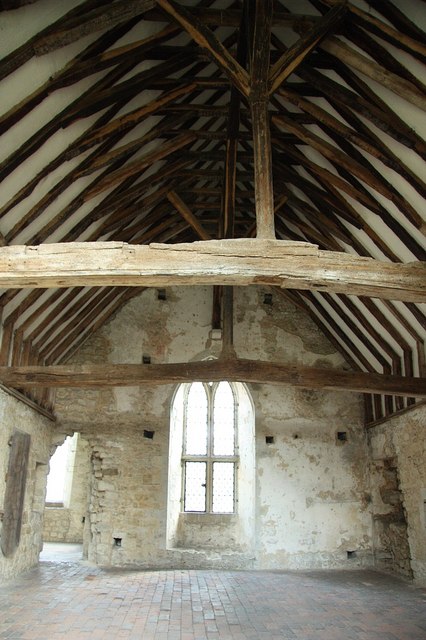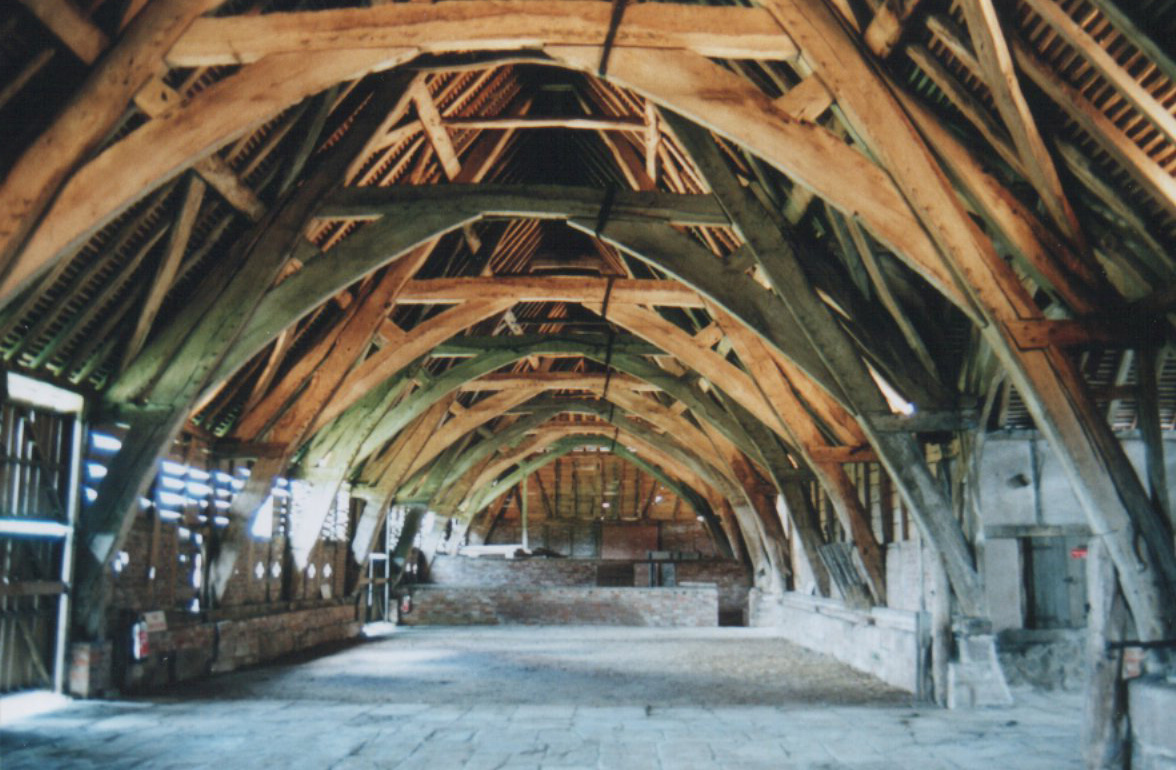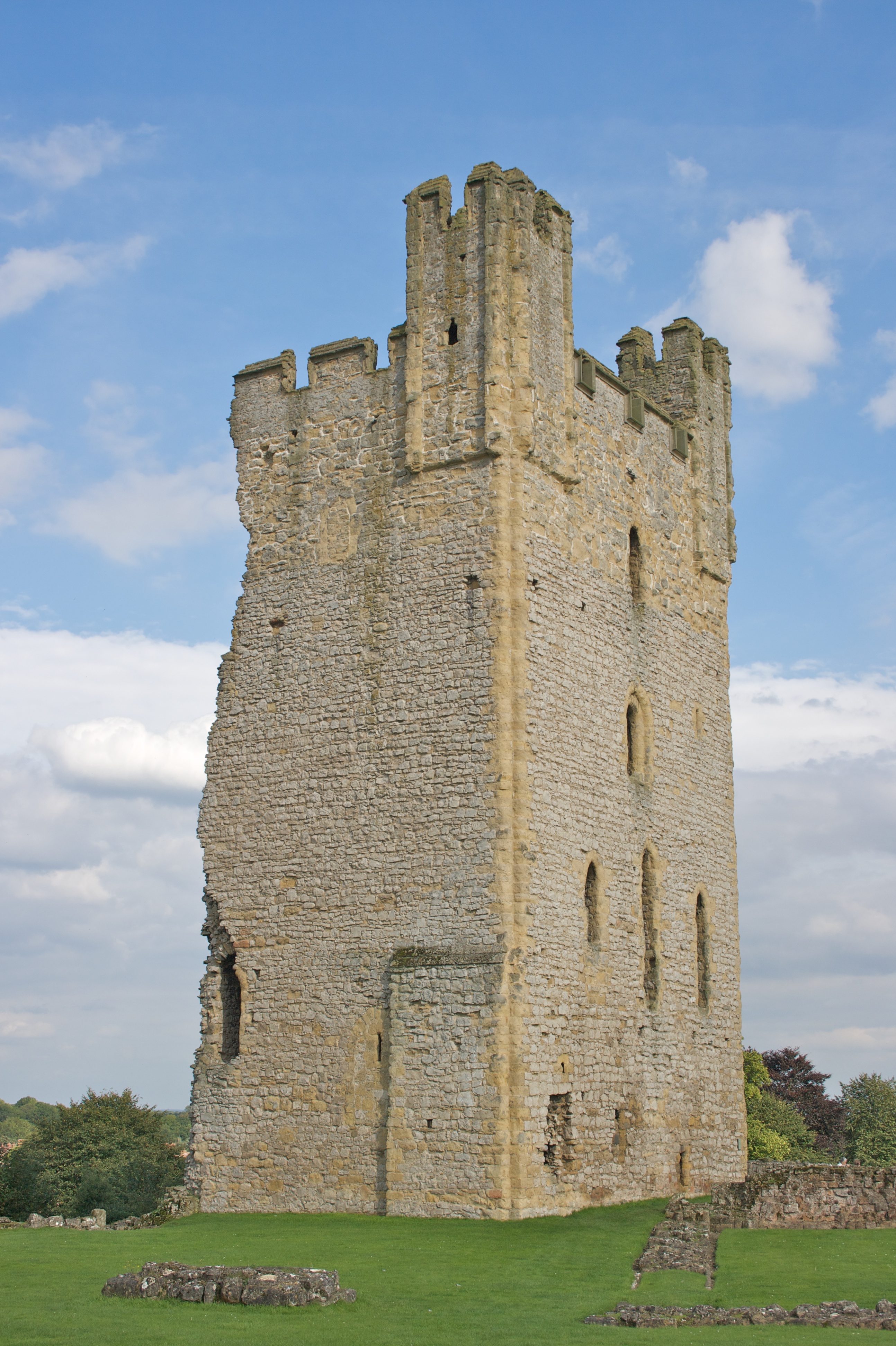|
Canon's Garth
Canons Garth is a historic building in Helmsley, a town in North Yorkshire, in England. The house was built in the late 14th century as a hall house with a cross passage and a rear aisle. It was possibly built for the canons of Kirkham Abbey. In the 17th century, a wing was added to the left, the cross passage removed and a central porch entrance created. Alterations by Temple Moore in 1889 included the creation of a chapel and study, and the replacement of all the windows. The house was restored in 1975, when the porch was rebuilt. In the early 20th century, the house served as a retreat for the Society of All Saints Sisters of the Poor. In about 1970, it became the parsonage for All Saints' Church, Helmsley, but it was sold off in 2011. The house has been grade II* listed since 1955. The ground floor of the house is in sandstone, the upper parts are timber framed, and the roof is tiled. It has two storeys and attics, and the house consists of a main range and projecting ... [...More Info...] [...Related Items...] OR: [Wikipedia] [Google] [Baidu] |
Dormer
A dormer is a roofed structure, often containing a window, that projects vertically beyond the plane of a Roof pitch, pitched roof. A dormer window (also called ''dormer'') is a form of roof window. Dormers are commonly used to increase the usable space in a loft and to create window openings in a roof plane. A dormer is often one of the primary elements of a loft conversion. As a prominent element of many buildings, different types of dormer have evolved to complement different styles of architecture. When the structure appears on the spires of churches and cathedrals, it is usually referred to as a ''lucarne''. History The word ''dormer'' is derived from the Middle French , meaning "sleeping room", as dormer windows often provided light and space to attic-level bedrooms. One of the earliest uses of dormers was in the form of lucarnes, slender dormers which provided ventilation to the spires of English Gothic architecture, English Gothic churches and cathedrals. An early ex ... [...More Info...] [...Related Items...] OR: [Wikipedia] [Google] [Baidu] |
Houses In North Yorkshire
A house is a single-unit residential building. It may range in complexity from a rudimentary hut to a complex structure of wood, masonry, concrete or other material, outfitted with plumbing, electrical, and heating, ventilation, and air conditioning systems.Schoenauer, Norbert (2000). ''6,000 Years of Housing'' (rev. ed.) (New York: W.W. Norton & Company). Houses use a range of different roofing systems to keep precipitation such as rain from getting into the dwelling space. Houses generally have doors or locks to secure the dwelling space and protect its inhabitants and contents from burglars or other trespassers. Most conventional modern houses in Western cultures will contain one or more bedrooms and bathrooms, a kitchen or cooking area, and a living room. A house may have a separate dining room, or the eating area may be integrated into the kitchen or another room. Some large houses in North America have a recreation room. In traditional agriculture-oriented societies, domes ... [...More Info...] [...Related Items...] OR: [Wikipedia] [Google] [Baidu] |
Listed Buildings In Helmsley
Helmsley is a Civil parishes in England, civil parish in the county of North Yorkshire, England. It contains 72 Listed building#England and Wales, listed buildings that are recorded in the National Heritage List for England. Of these, five are listed at Grade I, the highest of the three grades, seven are at Grade II*, the middle grade, and the others are at Grade II, the lowest grade. The parish contains the town of Helmsley and the surrounding countryside. In the parish is the English country house, country house of Duncombe Park, which is listed together with associated structures in the gardens and grounds. Also in the parish is Helmsley Castle, the remains of which are listed. Most of the other listed building are houses, cottages and associated structures, shops and offices. The others include churches, public houses and hotels, the market cross and a memorial in Market Place, bridges, farmhouses and farm buildings, former schools, the town hall and a telephone ... [...More Info...] [...Related Items...] OR: [Wikipedia] [Google] [Baidu] |
Grade II* Listed Buildings In North Yorkshire (district)
There are over 20,000 Grade II* listed buildings in England. This page is a list of 384 buildings in the unitary authority area of North Yorkshire North Yorkshire is a Ceremonial counties of England, ceremonial county in Northern England.The Unitary authorities of England, unitary authority areas of City of York, York and North Yorkshire (district), North Yorkshire are in Yorkshire and t .... As there are 536 Grade II* listed buildings in the district, the 152 churches and chapels are instead detailed in the article Grade II* listed churches in North Yorkshire (district). Notes {{Grad ... [...More Info...] [...Related Items...] OR: [Wikipedia] [Google] [Baidu] |
Crown Post
A crown post is a term in traditional timber framing for a post in roof framing which stands on a '' tie beam'' or '' collar beam'' and supports a ''collar plate''.Alcock, N. W.. Recording timber-framed buildings: an illustrated glossary. London: Council for British Archaeology, 1989. G5 Historically, crown posts were called king posts, but this usage is confusing and obsolete. A crown post is designed to be in a compression and transfers weight to the tie beam, where a king post is designed to be in tension and supports the tie beam. In the U.K a ''crown strut'' is similar to a crown post but does not carry a plate. Historical Context The use of crown post roofs became prominent in medieval England, particularly during the late medieval period. These roofs were commonly found in high-status buildings such as manor houses and large farm structures, where they provided both structural support and aesthetic appeal. One of the most famous examples is the crown post roof at Old ... [...More Info...] [...Related Items...] OR: [Wikipedia] [Google] [Baidu] |
Baxby Manor
Baxby Manor is a historic building in Husthwaite, a village in North Yorkshire, in England. The core of the manor house was built in about 1300. A chimney was inserted and a wing on the right was added in about 1600. The outer walls were encased in stone in the 18th century. The house was grade II listed in 1980. The building has recently served as a farmhouse. From the mid 1980s, part of the grounds were used as an unlicensed airfield. The building has a timber framed core encased in brown sandstone, and it has a pantile roof. At the rear, brickwork covers a base cruck, something found elsewhere in northern England only at Canons Garth in Helmsley. The house has two storeys, a main range of three bays, and a gabled cross-wing on the right. On the front is a doorway, and at the rear is a timber porch. Most of the windows are sashes, some horizontally-sliding, and there is a blocked mullion A mullion is a vertical element that forms a division between units of a wind ... [...More Info...] [...Related Items...] OR: [Wikipedia] [Google] [Baidu] |
Cruck
A cruck or crook frame is a curved timber, one of a pair, which support the roof of a building, historically used in England and Wales. This type of timber framing consists of long, generally naturally curved, timber members that lean inwards and form the ridge of the roof. These posts are then generally secured by a horizontal beam which then forms an "A" shape. Several of these "crooks" are constructed on the ground and then lifted into position. They are then joined together by either solid walls or cross beams which aid in preventing 'racking' (the action of each individual frame going out of square with the rest of the frame, and thus risking collapse). Etymology The term ''crook'' or ''cruck'' comes from Middle English ', from Old Norse ', meaning "hook". This is also the origin of the word "crooked", meaning bent, twisted or deformed, and also the crook used by shepherds and symbolically by bishops. Use Crucks were chiefly used in the medieval period for structures such ... [...More Info...] [...Related Items...] OR: [Wikipedia] [Google] [Baidu] |
Yale University Press
Yale University Press is the university press of Yale University. It was founded in 1908 by George Parmly Day and Clarence Day, grandsons of Benjamin Day, and became a department of Yale University in 1961, but it remains financially and operationally autonomous. , Yale University Press publishes approximately 300 new hardcover A hardcover, hard cover, or hardback (also known as hardbound, and sometimes as casebound (At p. 247.)) book is one bookbinding, bound with rigid protective covers (typically of binder's board or heavy paperboard covered with buckram or other clo ... and 150 new paperback books annually and has a backlist of about 5,000 books in print. Its books have won five National Book Awards, two National Book Critics Circle Awards and eight Pulitzer Prizes. The press maintains offices in New Haven, Connecticut and London, England. Yale is the only American university press with a full-scale publishing operation in Europe. It was a co-founder of the dist ... [...More Info...] [...Related Items...] OR: [Wikipedia] [Google] [Baidu] |
Helmsley Castle
Helmsley Castle (also known anciently as ''Hamlake'') is a medieval castle situated in the market town of Helmsley, within the North York Moors National Park, North Yorkshire, England. History Although the estate of Helmsley was granted to Robert, Count of Mortain following the Norman Conquest; there is no evidence that he built a castle in the area. The castle, constructed in wood around 1120, was built by Walter l'Espec. It is positioned on a rocky outcrop overlooking the River Rye. Featuring double ditches surrounding a rectangular inner bailey, the castle bears little resemblance to the motte and bailey castles built at the time (such as the nearby Pickering Castle). The castle at Helmsley was only from Rievaulx Abbey and Walter l'Espec granted the land for the abbey. Aelred, who was the abbey's first novice master, was known to be involved in l'Espec's affairs (military and personally) and Helmsley was often used as a place of safety during periods of instability. ... [...More Info...] [...Related Items...] OR: [Wikipedia] [Google] [Baidu] |
Rievaulx Abbey
Rievaulx Abbey ( ) was a Cistercian abbey in Rievaulx, near Helmsley, in the North York Moors National Park, North Yorkshire, England. It was one of the great abbeys in England until it was seized in 1538 under Henry VIII during the Dissolution of the Monasteries. The wider site was awarded Scheduled Ancient Monument status in 1915 and the abbey was brought into the care of the then Ministry of Works in 1917. The ruins of its main buildings are today a tourist attraction, owned and maintained by English Heritage. Foundation Rievaulx Abbey was the first Cistercian monastery in the north of England, founded in 1132 by twelve monks from Clairvaux Abbey. Its remote location was well suited to the order's ideal of a strict life of prayer and self-sufficiency with little contact with the outside world. The abbey's patron, Walter Espec, also founded another Cistercian community, that of Wardon Abbey in Bedfordshire, on unprofitable wasteland on one of his inherited estates. ... [...More Info...] [...Related Items...] OR: [Wikipedia] [Google] [Baidu] |
Salt Box
Salt box may refer to: * Saltbox house, an architectural style popularized in New England. * Saltbox, a lidded wooden box formerly for storing salt; also a little used term for a ''salt cellar'' — a serving container for salt. * Baltimore salt box, a yellow, lidded wooden box placed on Baltimore streets in winter to provide road salt Road salt (also known as de-icing salt, rock salt, or snow salt) is a salt used mainly as an anti-slip agent in winter road conditions, but also to prevent dust and snow build-up on roads. Various kinds of salts are used as road salt, but calciu ... for residents to spread. * The Salt Box, a Los Angeles Historic Cultural Monument destroyed by fire in 1969. {{Disambig ... [...More Info...] [...Related Items...] OR: [Wikipedia] [Google] [Baidu] |







